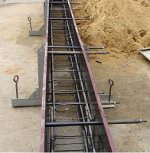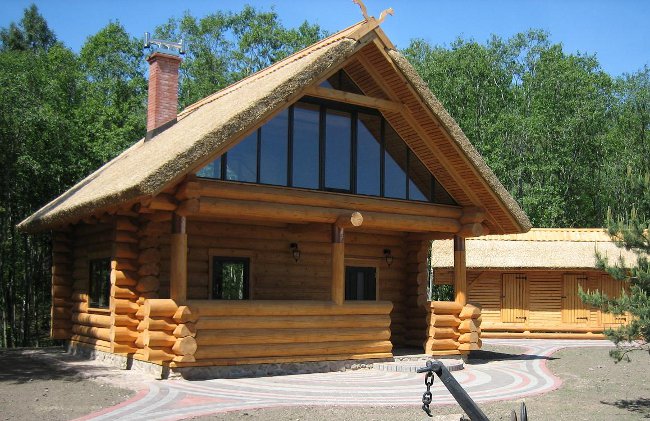Belt foundation by own hands

Belt foundation by own hands most often in private housing construction. For a dwelling house, a summer cottage, a bathhouse to make a ribbon foundation by one's own hands is quite realistic, but this will require some skills. Country tips will help you learn how to make a ribbon foundation yourself.
The foundation of the building must be strong, resistant to frost and groundwater. Usually, The weight of the foundation is up to 20% of the total mass erected building.
Belt foundation is a narrowrectangular (or other form) concrete construction, located under the building, along the entire perimeter. Often the structure of the foundation includes also stiffeners - additional sections. Tape foundation is performed either from blocks, or cast way. Ribbon foundation with their own hands is often performed just cast.
Before laying the foundation, its marking is done - based on the position of the future building on the site. Marking is carried out with the help of available means: a hammer, pegs and a rope. Instead of pegs, you can use the bars of the armature, instead of the rope - a strong fishing line or wire.
The axes of the future building should be determined: the plumb angle is determined by the plumb lineat home, then using a stretched cord (fishing line), perpendiculars are determined to 2 more points, after which the last, fourth corner of the house is determined with the help of a square.
Pegs or bars of reinforcement are driven into the received angles, a fishing line or rope is stretched between them. Parallelism of the boundaries of the obtained contouris determined by means of a tape measure: it is necessary to make measurements of each of the parties. Further, the perpendicularity of the obtained lines is checked: using the measuring roulette, the equality of the diagonals is verified.
The resulting marking defines the outer boundaries of the ribbon foundation, then the inner boundaries must be defined. The width of the trench of the belt foundation should not be less than the width of the walls of the erected building. The minimum width of the trench is 40-60 cm.
After completing the foundation marking, the excavation work should begin. First of all, the turf is removed from the site and the top layer of the soil is removed, to a depth of about 15-20 cm. It is not worth throwing out this land, it is better to use it for fertilizing the garden / garden.
On the ground with the help of a plumb and roulette the contours of the trench are made for the basement and the excavation of the trench is made. The walls of the trench must be strictly vertical. Strengthen the trench before pouring the foundation can be formwork and time struts.
When laying the foundation it is very important to analyze the soil on the site. The belt foundation with its own hands is laid on the sand, gravel or loose ground at a depth of 1 m, on sandy loam and loamy - 1,25 m, on clay - 1,54 m, on especially dense - 2 m.
The ground when excavating a trench is conveniently removed with a bayonet or shovel. With increased density of soil, it is recommended to loosen it with a pickax or a hoe, a crowbar. Trench digging should begin with a hill. Do not exceed the maximum calculated depth of the trench.
The belt foundation with its own hands contains the so-called sand pillow - a layer of sand 15-20 cm thick, intendedto soften the load on the lower part of the foundation, save construction materials, remove weak and loose soils located at the base of the trench.
When laying a sand pillow It is important to ensure that the top layer of sand does not contain slopes and swings. After filling the trench with sand, it must be carefully tampered using water for this.
On the edge of the trench, a formwork is being constructed - to erect part of the foundation that is above the ground surface. The formwork is most often made of wooden boards, plywood, as these materials are quite cheap.
The formwork of the belt foundation is assembled on the ground, the assembly process is a Knocking or twisting screws with wooden shields. Hats of nails or screws are located withinner side of the formwork. Instead of wooden, you can use a reusable metal formwork, which allows you to get perfectly smooth foundation walls.
The belt foundation is reinforced with its own hands. Reinforcement is made by means of reinforcementsection 12 mm, the reinforcement is located inside the foundation, approximately 5 cm from the edges. The armature falls in 2 rows to the bottom of the formwork, then lateral crosspieces are attached - with the help of knitting wire and pliers.
Before pouring the foundation in it if necessary communication taps are being carried out: for electricity, water pipes andsewage system. Pouring the foundation is done by hand-made solution at home or is made from a car mixer by factory-made concrete. The second option is preferable, although more expensive.
Pouring of concrete is made to the level of a pre-fixed line, during pouring concrete is rammed to avoid the appearance of air bubbles. At the end of pouring, the surface of the concrete is leveled - an ordinary trowel will do.
Full hardening of the concrete requires up to three weeks. In case of overcast or rainy weather, the foundation should be covered with a film. If the strip foundation is under direct sunlight, it is necessary to periodically water its upper layer.
The belt foundation is ready by our own hands and, after the time set for solidification, it will be possible to start building the walls. However, in order to avoid unforeseen results and fatal errors, However, it is better to entrust the manufacture of the belt foundation to specialists. Professional foundation erection, perhaps, will cost more, but the safety and strength of the resulting design will be higher.














